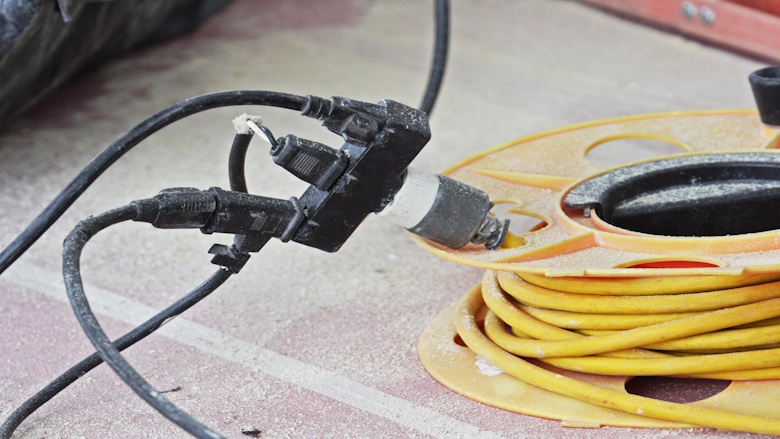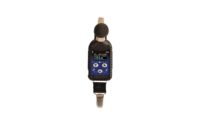It’s one thing to lose hours of set-up time on a job site with unlabeled cables and wires; it’s another to trip and fall (or cause a colleague to do the same), thanks to exposed cords.
Any location with cords, cables, and wires puts employees and their equipment in danger when left out. A single extension cord or loose cable on the ground can lead to thousands of dollars in damages and even the possibility of death.
Anything on the ground is a hazard
There are signs to mark a wet floor or tell people to watch their step, but frequently, we ignore cords on the floor, not realizing they are just as much a work hazard as everything else. Simply put, anything on the ground that shouldn’t be there is a tripping hazard.
Slip, trip, and fall injuries account for 15-25% of all workplace injuries. The severity of these injuries isn’t consistent: sometimes, it’s only a pulled muscle, but other times, slips, trips, and falls cause an accidental death.
Tripping hazards don’t just come from an extensive collection of wires; a simple extension cord left on the floor, an ethernet cable stretched across the room or an XLR cable dangling a couple of feet off the ground on stage is enough to cause significant problems.
A costly oversight
The next time you see any cable on the floor, understand just how financially costly that could be.
According to the 2021 Liberty Mutual Workplace Safety Index, slips, trips, and falls account for over $19 billion in yearly damages, averaging around $22,000 per incident.
That doesn’t account for broken equipment from a cord ripped out of its port or a tangle-related short circuit.
Identifying on-site cable management risks
When working on-site, scoping out your surroundings to understand the potential safety risks is essential. When it comes to protecting yourself, employees, and equipment from poor cable management, identifying all potential pitfalls ahead of time allows you to perform your duties in a way that protects others.
Every worksite is different and requires different management techniques: on construction sites, you must watch out for welding, power tools, and temporary lighting cables. On the other hand, if you’re working in a data center, you’ll likely need to manage ethernet and fiber optic cables.
Figure out the correct measurements
You must measure the distance between the equipment and available outlets or plugs.
If you’re having trouble measuring, a quick hack is that with your arms spread out, from fingertip to fingertip is approximately your height. Use this method to quickly eyeball how much cable you’ll need to avoid stretching cords from one end to the other.
Don’t let cables and cords lie on the floor
If cables are already plugged in around the building, ensure they are not lying on the floor. Don’t just pick them up; figure out the best way to keep them from anyone’s walking path.
Any wire, cable, or cord lying on the ground or stretched across walking paths is dangerous to everyone’s safety.
Data center and electrical cable management
For data centers, we recommend routing your ethernet, power, and fiber optic cables along walls and door frames.
According to OSHA regulations, “flexible cords and cables shall be supported in place at intervals that ensure that they will be protected from physical damage. Support shall be in the form of staples, cable ties, straps, or similar type fittings installed so as not to cause damage.”
While staples are commonly used, it’s recommended that you use reusable hook and loop straps or Velcro Brand fasteners (including tape) as they allow you the flexibility to maneuver difficult wires without having to worry about them losing their hold.
Coaxial cable staples or wire clips are safer when maneuvering ethernet cables around doorways and window frames. Command strips also do the job if you’re looking for a solution that won’t leave any holes in your walls.
In a desperate situation, painter’s tape can do the job temporarily. Just know that depending on the humidity, varnish, and other environmental elements, painter’s tape won’t hold up forever.
Move the cables inside
Another option is to drill holes and move the cables through the walls. While a bit more time-consuming, organizing the cords around your office allows for a much cleaner look and limited opportunities for the cables to become unattached to the wall and fall to the floor.
This method allows you to maneuver ethernet cables between rooms without figuring out the best way to get them through doorways.
Setting cable management expectations
Everyone is responsible for protecting themselves and their colleagues from slips, trips, and falls. The employer and supervisors must be notified immediately if there are any potential dangers at your worksite.
No cords on the floor
The most important rule is if there’s a cord on the floor, there’s a danger present. Cables should not be too long, stretched out over walking paths, or lying on the ground.
Use hook and loop wraps and fasteners to prevent wires, cords, or cables from falling into pedestrian walkways.
Avoid extension cords
Avoid extension cords at all costs, as they significantly contribute to trip and fall accidents. If, for some reason, you must use an extension cord, purchase brightly colored hook and loop cable ties to indicate that the cord is on the ground, as well as fasten it to the floor with either regular or Velcro brand tape.
According to OSHA regulations, “extension cords shall not be fastened with staples, hung from nails, or suspended by wire.”
Properly label and wrap cables
Rather than a tangled mess of cables, use cable wraps or hook and loop ties to bundle them together, allowing for a cleaner, safer look around the office. For data centers, bundling ethernet cables also allows for quicker installation.
If given the option, choose custom-printed cable ties because labeling each wire before installation enables you to identify and switch out broken cables quickly.
Preventing trips and falls through cable management
Following proper cable management procedures to protect yourself and your business from unnecessary workplace injuries is a no-brainer.
Remember always to stay aware of your surroundings, plan out your workspaces appropriately, and instill the expectations around the building that cords, cables, or wires must always be routed along the outside or inside the walls.



